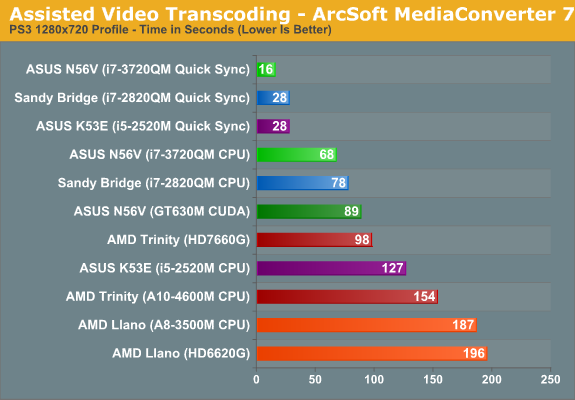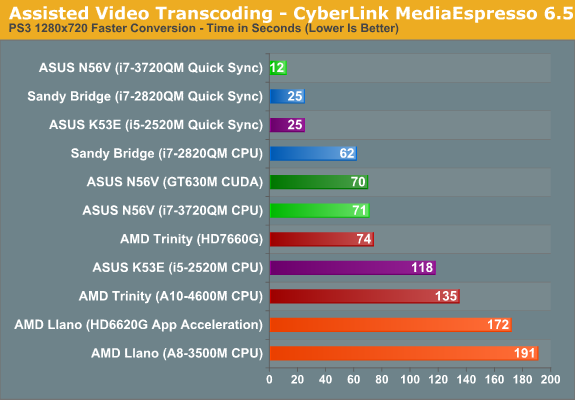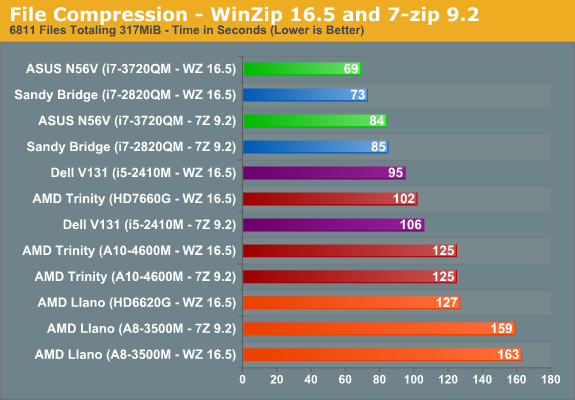The AMD Trinity Review (A10-4600M): A New Hope
by Jarred Walton on May 15, 2012 12:00 AM ESTAMD’s Heterogeneous Computing with Trinity
It’s not all about just CPU or GPU performance, though—or at least that’s what we’ve been hearing from various parties for a while now. The real question is how a platform performs as a whole. There are some tasks where pure CPU performance is what really matters, and there are other tasks where the parallel nature of GPUs pays serious dividends. AMD (and NVIDIA) has been pushing for more applications to make use of the GPU for tasks where it can provide a lot of number crunching prowess.
With Trinity, AMD provided us with a selection of applications that now leverage—to varying degrees—AMD’s App Acceleration, OpenCL, OpenGL, or other tools. For some of these applications, we don’t have any good way of measuring performance across a wide selection of hardware, and for some of those where benchmarks are possible I’ve run out of time to try to put anything concrete together. I don’t want to skip this section entirely, so what follows is a list of the applications, how they benefit from heterogeneous compute, and some general impressions of the application. We also have graphs for a few of the applications where performance seemed to matter the most.
Adobe Flash 11.2—The latest version of Flash continues to add GPU acceleration features, and now there are 3D hooks in addition to the video offload acceleration we first saw with Flash 10.x. There’s not too much of note here, as NVIDIA and Intel also support the latest features of Flash 11.2. Flash works fine on Trinity, but the same goes for Ivy Bridge and various NVIDIA GPUs. If you never saw the Epic Citadel demo for iOS or Android, there’s now a Flash-based version of the same demo that will run in your browser. (Warning: that link can take 10-15 minutes on a decent connection to download all the textures and other data!) Epic Citadel looks just as nice as it did on iOS, but now we need some actual games to take advantage of the tools. Then perhaps we can start looking into benchmarks of browser games or something….
Adobe Photoshop CS6—Photoshop started to take advantage of GPU acceleration back with the CS4 release, using OpenGL to improve performance on certain filters and features. With CS6, Adobe has begun using OpenCL. Fundamentally, I’m not sure how big of a change this represents, but there are quite a few functions in Photoshop that are now supposed to be faster/better with an OpenCL compatible graphics card. There are also two new features that leverage OpenCL; one is Iris Blur, which allows you to mimic depth of field using Photoshop instead of your camera, and the other is Liquify. Unfortunately, I’m by no means a Photoshop expert, so I’m not sure how much the features really help “power users”. I did try doing a benchmark of general Photoshop CS6 performance using the Photoshop Retouch benchmark with and without GPU acceleration enabled; unfortunately, it looks like most of the filters in that action script don’t benefit from the GPU acceleration, as the scores I got were essentially unchanged with or without GPU/OpenCL enabled. Overall, I’ll take the GPU acceleration, but for most of what I do in Photoshop it doesn’t appear to benefit; if you’re interested, you can read more about AMD’s work with Adobe.
GNU Image Manipulation Program (GIMP)—Going along with Photoshop CS6, AMD provided a special preview build of GIMP 2.8. GIMP is sort of the poor man’s Photoshop, as it’s completely free. At present, there are 19 filters that utilize OpenCL to speed of processing, and over the coming months as the release version of GIMP looks to take their new engine live there will undoubtedly be more additions. For now, probably only five of the filters are things I would use (e.g. noise reduction, maybe a light blur). I tested several of these, and there is sometimes an order of magnitude speedup vs. doing the work on just the CPU. The problem is that it also looks like GIMP isn't incredibly well threaded in many of these tasks, putting multicore CPUs at a disadvantage. My biggest complaint isn’t even about performance, though; sadly, I just find the GIMP UI and general performance to be really bad compared to Photoshop. I've tried several times over the years to use GIMP instead of Photoshop, but I’ve never felt comfortable with the tool. If on the other hand you prefer GIMP, hopefully when the current GEGL menu gets integrated into the main program you’ll realize a healthy performance boost.

ArcSoft MediaConverter 7.5—MediaConverter should be a familiar name by now if you’ve been following our reviews, as it’s one of the showcase titles for Intel’s Quick Sync transcoding. When we reviewed Ivy Bridge last month, we found that on Llano at least the version of MediaConverter we had ran slower on the GPU than on the CPU; with Trinity on the other hand, enabling GPU acceleration results in times that are about 60% faster than the CPU alone. That’s a good performance increase, but we’re looking at 154 seconds on the CPU compared to 98 seconds using the GPU. In contrast, dual-core Sandy Bridge on CPU transcoding took 127 seconds and with Quick Sync it only took 28 seconds—a 5X improvement. Quad-core Ivy Bridge was just as impressive, going from 68 seconds on the CPU down to 16 seconds with Quick Sync (4.25X). We’ve been hoping to see something more from AMD’s new Video Codec Engine (VCE), first announced over six months ago with HD 7970, but unless there’s substantial room for improvement it looks like Intel’s Quick Sync will continue to be the fastest transcoding tool for now.

CyberLink MediaEspresso 6.5—This tool is very similar to MediaConverter, and the results are also better this time around. We measured the assisted encode time at 74 seconds compared to 135 seconds on the CPU alone. The 74 second transcode time actually makes Trinity potentially faster than CPU-based transcoding on dual-core Sandy Bridge, but again Quick Sync (25 seconds on SNB, 12 seconds on IVB) remains the fastest way to transcode. Considering both of these tools are apparently using VCE, I have to state that I’m disappointed; with VCE I was expecting performance similar to what Intel is getting with Quick Sync—four or five times faster than CPU-based encoding for the same APU. That Trinity isn't quite twice as fast with VCE is unfortunate; even though there's a decent improvement, Intel is in a completely different category of performance. We’ll have to wait and see if anything more develops with VCE.

Handbrake— Yep, this popular open source video transcoding app is getting an OpenCL facelift. Check out our separate post on it here.
WinZip 16.5—This final application is one that I can see being very useful, assuming we see similar advancements in other compression utilities. WinZip 16.5 now supports OpenCL to improve compression times. We tested by compressing the entire Cinebench 11.5 directory with and without OpenCL enabled, and we also compared the results with 7-Zip. On Trinity, performance improved by about 20%, which is decent; Llano sees an even larger 28% improvement. Meanwhile, Sandy Bridge using CPU-based compression is about as fast as Trinity with OpenCL, and Ivy Bridge is still faster, but the 20% increase for “free” is nothing to scoff at. Unfortunately for WinZip, 7-Zip compressed the same directory to 95MB vs. 108MB in roughly the same time as the non-OpenCL WinZip, and 7-Zip is completely free and doesn't nag you and tell you to buy it. Where WinZip 16.5 is a good proof of concept, what will really help AMD is if all the other compression utilities (7-Zip, WinRAR, etc.) all start using OpenCL or other tools to improve performance.
The majority of the applications continue to focus on video and image manipulation, likely because those are areas where the parallel nature of GPUs can be readily utilized. WinZip on the other hand is an application showing other potential uses for GPGPU and heterogeneous compute. We’d love to see even more adoption of OpenCL and similar tools, but the stark reality is that coming up with new and useful ways of doing this is difficult—if it were easy, everyone would do it! The good news is that giving the creative people of the world more tools with which to work can only help, and we’ll just have to wait and see what else comes out.
There’s another interesting sidebar worth mentioning here. OpenCL is an open standard, and the latest Intel drivers actually install an OpenCL driver on Ivy Bridge and Sandy Bridge. Not surprisingly, not all implementations are created equal, so even with Intel’s drivers we couldn’t enable OpenCL in Photoshop or WinZip; GIMP on the other hand apparently worked okay with OpenCL on Intel—we measured a 5X performance improvement of the Noise Reduction filter with Ivy Bridge. Trinity also came in slightly faster with both leveraging OpenCL, while Intel was nearly twice as fast without.










271 Comments
View All Comments
raghu78 - Tuesday, May 15, 2012 - link
AMD needs to do much better with their CPU performance otherwise its looking pretty bad from here.Intel Haswell is going to improve the graphics performance much more significantly. With some rumours of stacked DRAM making it to haswell it looks pretty grim from here. And we don't know the magnitude of CPU performance improvements in Haswell ? AMD runs the risk of becoming completely outclassed in both departments. AMD needs to have a much better processor with Steamroller or its pretty much game over. AMD's efforts with HSA and OpenCL are going to be very crucial in differentiating their products. Also when adding more GPU performance AMD needs to address the bandwidth issue with some kind of stacked DRAM solution. AMD Kaveri with 512 GCN cores is going to be more bottlenecked than Trinity if their CPU part isn't much more powerful and their bandwidth issues are not addressed. I am still hoping AMD does not become irrelevant cause comeptition is crucial for maximum benefit to the industry and the market.
Kjella - Tuesday, May 15, 2012 - link
Well it's hard to tell facts from fiction but some have said Haswell will get 40 EUs as opposed to Ivy Bridge's 16. Hard to say but we know:1. Intel has the TDP headroom if they raise it back up to 95W for the new EUs.
2. Intel has the die room, the Ivy Bridge chips are Intel's smallest in a long time.
3. Graphics performance is heavily tied to number of shaders.
In other words, if Intel wants to make a much more graphics-heavy chip - it'll be more GPU than CPU at that point - they can, and I don't really see a good reason why not. Giving AMD and nVidia's low end a good punch must be good for Intel.
mschira - Tuesday, May 15, 2012 - link
Hellooouuu?Do I see this right? The new AMD part offers better battery life with a 32 nm part than Intel with a spanking new 22nm part?
And CPU performance is good (though not great...)?
AND they will offer a 25W part that will probably offer very decent performance but even better battery life?
And you call this NOT earth shattering?
I don't understand you guys.
I just don't.
M.
JarredWalton - Tuesday, May 15, 2012 - link
Intel's own 32nm part beats their 22nm part, so no, I'm not surprised that a mature 32nm CPU from AMD is doing the same.Spunjji - Tuesday, May 15, 2012 - link
...that makes sense if you're ignoring GPU performance. If you're not, this does indeed look pretty fantastic and is a frankly amazing turnaround from the folks that only very recently brought us Faildozer.I'm not going to chime in with the "INTEL BIAS" blowhards about, but I do agree with mschira that this is a hell of a feat of engineering.
texasti89 - Tuesday, May 15, 2012 - link
"Intel's own 32nm part beats their 22nm part", how so?CPU improvement (clk-per-clk) = 5-10%
GPU improvement around 200%
Power efficiency (for similar models) = 20-30% power reduction.
JarredWalton - Tuesday, May 15, 2012 - link
Just in case you're wondering, I might have access to some other hardware that confirms my feeling that IVB is using more power under light loads than SNB. Note that we're talking notebooks here, not desktops, and we're looking at battery life, not system power draw. So I was specifically referring to the fact that several SNB laptops were able to surpass the initial IVB laptop on normalized battery life -- nothing more.vegemeister - Tuesday, May 15, 2012 - link
Speaking of which, why aren't you directly measuring system power draw? Much less room for error than relying on manufacturer battery specifications, and you don't have to wait for the battery to run down.JarredWalton - Wednesday, May 16, 2012 - link
Because measuring system power draw introduces other variables, like AC adapter efficiency for one. Whether we're on batter power or plugged in, the reality is that BIOS/firmware can have an impact on these areas. While it may only be a couple watts, for a laptop that's significant -- most laptops now idle at less than 9W for example (unless they have an always on discrete GPU).vegemeister - Wednesday, May 16, 2012 - link
You could measure on the DC side. And if you want to minimize non-CPU-related variation, it would be best to do these tests with the display turned off. At 100 nits you'll still get variation from the size of the display and the efficiency of the inverter and backlight arrangement.